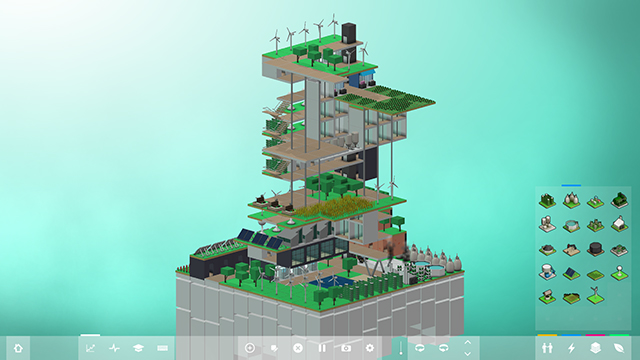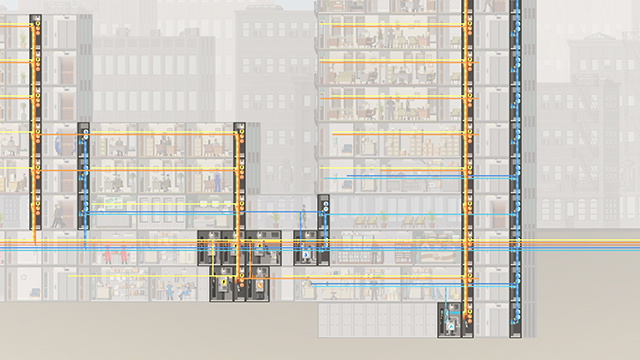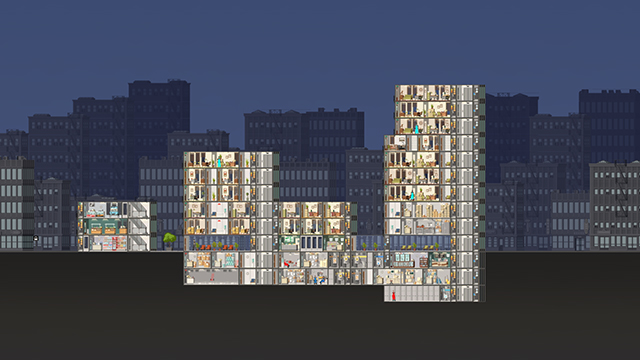My favorite of all the Sim games from Maxis is SimTower. Building cities in SimCity always felt like too large a task, I’d get bored of The Sims after a short amount of time, and the others, well, I just couldn’t get into them. I remember buying SimTower and feeling ever-increasing excitement build up within me throughout the day as my family continued to drag me around the mall for another few hours. But when I finally did sit down with the game, I was hooked for months. Something about the simple interface, the icons representing various building residences, and the lines of people waiting for elevators entranced little boy Gil in a way the other sims haven’t accomplished.
Having missed Yoot Tower’s existence entirely, I longed for a proper sequel but never received one. Fast forward to last week during GDC, and I’m not just given one but two vertical tower building simulators to preview, Block’hood and Project Highrise. Although the latter is probably closer to the spiritual successor I’ve been looking for, both games offer engaging gameplay that is nostalgic and a departure from my childhood favorite. Frankly, I’m looking forward to each of their summer releases.
While both Block’hood and Project Highrise ostensibly have similar premises—build a tower—the way they deal with resources is what ultimately sets them apart. Block’hood is not so much about constructing a building so much as a fully self-sustaining environment. If we were to use SimCity buildings for comparison, you’re building the arcology instead of the skyscraper. Jose Sanchez, the plethora-project’s developer, sees this game as an opportunity to get players thinking about environment in a different dimension.
Before you can even construct one apartment, you need to create an environment that’s generating resources, such as electricity, to sustain it. Then, walkways need to be laid down so people can arguably access it. Unlike SimTower, placing a unit without proper resources to sustain it will cause it to decay, which is actually a point of no return in Block’hood. Each piece you can place is equivalent to one box in this game’s 3D interface, and it’s not long before one decaying piece becomes a whole chunk of your city. Players will need to monitor production levels on things such as water, fresh air, leisure space, consumers for stores, sickness, and pollution. Aside from specific modes to look at any one of these resources—note that they are all grouped together despite some having negative connotations—the main view of your tower will have units blinking to indicate how well it’s doing in the production cycle.
By contrast, Project Highrise is more about the skyscraper. Compared to its inspiration, though, there is a ton of micromanagement to contend with. Despite his nostalgia, Somasim’s designer, Matthew Viglione, astutely noted that SimTower was an elevator simulation with building management tacked on. His goal with his game was to really put players in control of a building. Resources in this scale, besides public utilities, is about meeting customer needs. For example, depending on whom you rent office space to, they might need copy and fax services, shipping services, or just water cooler refills. Basically, rental agreements come down to full-service contracts, and you need to determine what kind of businesses you wish to attract and how much spending money on another service will be worthwhile to you.
In a curious turn, despite the fact that Block’hood has an inherent focus on ecology and environment, its scope is entirely insular. Your tower of resources and populated space survives on its own, floating on a mysterious island of white blocks. Project Highrise, on the other hand, has a scope outside of your building. The developers see your building as part of the surrounding city—you make contracts with the city to get money advances, you puts ads out to reel in new tenants, and your selection of retail tenants determines how many people come from outside the building to visit it.
Where they also differ is when it comes to the invisible hand that drives many sim games. In Project Highrise, you hire workers to build out floors and then the spaces you’ll be renting out. The game begins with two workers*, so if you try to build out four offices, you’ll need to wait for them to finish the first two before moving on. It conveys a sense of realism while still fudging reality enough to be worthy of a gamer’s time. Yet in Block’hood, the people who drive construction and who live in your space remain invisible. Their needs, in terms of sustainable living, must be considered, but they are expressed via coloration on a view mode. The developers are working on a module to include people, but they remain focused on the base simulation for the time being.
Despite their differences, both games clearly drive players to put a lot of consideration into their projects. In both, putting down residences or rental space is not simply a matter of looking at your wallet and deciding from there. Instead, both current and future resources and consequences must be considered. There is a lot of room for failure, but there is even more room for introspection and discussion. And I think both games will serve as reminders that nothing you try to accomplish will happen in a vacuum.
*The workers “live” in your building in spaces built out for them. When you eventually build fast food joints and the like, they will patronize those, but otherwise, they sit and stare out into space from their hovels. When I objected to this, Somasim indicated that originally, they left and went home at night like real workers, but beta testers objected on the grounds that they didn’t like being unable to build at night. My conclusion is that some players are really shitty.
Block'hood
-
Block'hood #1

-
Block'hood #2

-
Block'hood #3

-
Block'hood #4

-
Block'hood #5

-
Block'hood #6

-
Block'hood #7

-
Block'hood #8

-
Block'hood #9

-
Block'hood #10

-
Block'hood #11

-
Block'hood #12

Project Highrise
-
Project Highrise #1

-
Project Highrise #2

-
Project Highrise #3

-
Project Highrise #4

-
Project Highrise #5

-
Project Highrise #6








